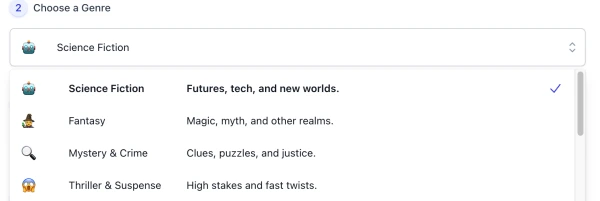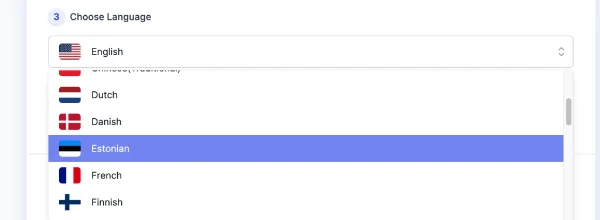This is the AIFreeBox AI Story Ideas Generator page — an online inspiration-trigger writing assistant that helps creators find clear, directed story ideas across genres.
On This page, you’ll find the tool’s purpose and capabilities, its practical use in real writing, guidance on how to use it well, creative tips, potential limitations with solutions, and FAQs.All focus to help storytellers find usable ideas that guide real writing.
What Can AIFreeBox AI Story Ideas Generator Do?
Built on transformer-based large language models with task-specific fine-tuning, this tool generates story ideas that are both creative and directed. It supports 33 languages and 12 distinct genres, allowing writers to explore inspiration across cultural and thematic boundaries.
The design emphasizes clarity and usability: ideas are short, original, and aligned with the chosen genre. It is not an automatic “ghostwriter” for full novels, but an inspiration-trigger assistant that helps creators break blocks and discover workable starting points.
Each idea serves as a seed for character design, plot expansion, or moving into the Plot Generator. The focus is on human–AI collaboration, where the tool sparks possibilities and the writer shapes them into complete stories.
AIFreeBox Story Ideas Generator vs. Random Idea Generators
Key differences in value and output
| Dimension |
AI Story Ideas Generator |
Generic “Random Idea Generator” |
| Content Quality |
Directed, genre-specific ideas with clear starting points |
Vague, disjointed ideas with low writing value |
| Usability |
Ideas guide real writing; seed characters or plots |
Needs heavy rewriting to be useful |
| Diversity |
Varies protagonist, conflict, and setting; avoids repetition |
Often repetitive or cliché |
| Design Principle |
Inspiration-trigger; human–AI collaboration, not ghostwriting |
Random output; no creative direction |
| Language & Genre Support |
33 languages, 12 refined genres |
Limited options, often English-only |
| Value to Writers |
Provides usable seeds that grow into stories |
Amusement over depth; low conversion to drafts |
Common Situations and Who It Supports
Recommended reasons, scenarios, and target users
| Scenario |
Problem Solved |
Who Benefits |
| Writer’s Block |
Unblocks stalled creativity with clear starting points |
Novelists, short story writers |
| Genre Exploration |
Offers directed ideas across 12 genres |
Fiction writers testing new themes |
| Script Brainstorming |
Quick loglines to expand into screenplays or plays |
Screenwriters, playwrights |
| Classroom & Study Use |
Supports assignments, creative writing practice |
Students, educators |
| Content & Marketing |
Fresh angles for storytelling in campaigns |
Content creators, marketers |
| Multilingual Projects |
Generates culturally natural ideas in 33 languages |
Global writers, translators |
| Idea Validation |
Gives multiple takes to compare and refine |
Writing groups, editors |
How to Come Up with Story Ideas with AIFreeBox AI:
Step-by-Step Guide

Step 1 — Provide Your Topic or Keywords
Enter a short premise, theme, or keywords in the input box (e.g., “time travel; cultural evolution”). Empty input is allowed, but specific prompts produce more directed ideas.
Step 2 — Choose a Genre

Select one of the 12 Genres (e.g., Science Fiction, Mystery & Crime). This constrains tone, conflicts, and settings so the ideas are usable for real writing.
Step 3 — Choose Language

Pick your output language. The tool adapts names and references to the chosen language for cultural fit in downstream writing.
Step 4 — Set Creativity Level
Use the slider (1–10). “5” is a balanced default; lower values yield safer, more conventional ideas; higher values yield bolder variations. Adjust to match your project’s needs.
Step 5 — Generate
Click Generate. You’ll receive concise, directed story ideas aligned with the selected Genre and Language.
Step 6 — Download or Copy
Use Download to save results, or Copy to paste into your notes, outline, or a Plot tool for expansion.
Step 7 — Report Bug (Real Human Support)

Click Report Bug if outputs appear off-target (wrong language, repetition, policy issues, or UI problems). A human reviewer monitors reports and responds promptly. For faster diagnosis, include: your input, selected Genre, Language, creativity level, timestamp, and what you expected vs. what you saw.
Summary: Treat each result as a starting point — carefully review whether it fits your project’s goals, and adapt details (audience, setting, names) to your cultural context so the idea is ready for real-world writing.
Tips for Generating Better Story Ideas
- Be Specific with Input: Instead of a single word, add a short phrase or context (e.g., “time travel family drama” works better than “time travel”).
- Match Genre Carefully: Pick the genre that best reflects your target project; this helps avoid ideas that feel off-tone.
- Adjust Creativity Level: Use lower settings for grounded plots, higher settings for bold or unconventional directions.
- Use Native Language: If writing in a non-English language, set [${language}] to get culturally natural names, settings, and dialogue styles.
- Refine by Comparison: Generate multiple rounds and compare; keep the ideas that spark characters, settings, or conflicts you can expand.
- Tag Ideas Early: Save, copy, or note down the tags (subgenre, audience) to help sort and revisit them later.
Reminder: These tips help you move from raw outputs to directed, usable inspiration that fits real writing needs, making each idea a stronger starting point for storytelling.
User Case Study: From Idea to Writing Seed
Case A — Short Story Assignment (Student)
1) User Input
- Content: “A neighborhood changes after a mysterious letter appears on every doorstep.”
- Genre: Contemporary Drama
- language: English
2) AI Output (excerpt)
- Logline: A shy teen tracks the source of identical letters, uncovering quiet bargains reshaping her street.
Tags: community, coming-of-age, urban
- Logline: A postal worker refuses to deliver the letter to one house, triggering a chain of revelations.
Tags: ethics, secrets, neighborhood
3) Human Edits & Decisions
- Picked the postal worker angle; changed job to substitute courier for believability.
- Localized names and landmarks to fit the city’s culture and school calendar.
- Added a concrete obstacle: workplace policy vs. personal conscience.
4) Resulting Writing Seed
Seed: “A substitute courier refuses to deliver a letter to one address, risking her temporary contract as the street’s quiet deals begin to surface.”
Next step: Expand in Plot tool → character goals, stakes, and a two-scene outline for a 1,500-word short story.
Case B — Thriller Brainstorm (Screenwriter)
1) User Input
- content: “A long-haul driver receives GPS routes that don’t exist on any map.”
- genre: Thriller & Suspense
- language: English
2) AI Output (excerpt)
- Logline: A trucker follows phantom GPS routes that reroute him toward a decades-old cover-up.
Tags: conspiracy, isolation, road
- Logline: After a wrong turn onto an unmapped road, a driver finds towns that appear only once a year.
Tags: liminal, time anomaly, survival
3) Human Edits & Decisions
- Chose the cover-up angle; grounded tech details (device model, dispatch logs) for realism.
- Adjusted setting to a region the writer knows; aligned law-enforcement procedures with local practice.
- Defined a concrete midpoint twist: the GPS vendor is a shell for a private security firm.
4) Resulting Writing Seed
Seed: “A long-haul driver logs phantom routes that point to a buried crash investigation, forcing him to choose between safety and exposure.”
Next step: Move to Plot tool → three-act beats and a one-page synopsis for a pilot script.
Reminder: Treat each generated idea as a starting point. Review it quickly against your project goals, adapt names, settings, and references to your cultural context, and then expand—so the idea becomes truly usable in real-world writing.
Limitations & Practical Solutions
Common issues and how to address them
| Limitation |
What You Might See |
Solution |
| Generic ideas |
Outputs feel vague or interchangeable |
Add more context in your content; choose a precise genre |
| Repetition |
Similar protagonists or conflicts across ideas |
Regenerate; vary input keywords; switch genre |
| Off-genre tone |
Ideas don’t fit chosen genre |
Re-check genre; add a tone cue in input |
| Cultural mismatch |
Names or settings feel unnatural |
Set correct language; specify locale; post-edit |
| Too safe or too wild |
Predictable or implausible plots |
Adjust creativity slider; add clear constraints |
| Language issues |
Mixed languages or grammar errors |
Confirm language; regenerate; quick manual edits |
| Technical/UX errors |
Broken lines, slow generation, missing buttons |
Retry; shorten input; use Copy; report via Report Bug |
FAQs
Can this tool write a full novel for me?
No. The AI Story Ideas Generator is not a ghostwriting tool. It provides starting points—clear, directed story ideas you can expand into full works yourself.
How should I use the generated ideas?
Treat each idea as a seed. You can keep, refine, or expand it into characters, plots, or outlines. For structured development, transfer chosen ideas into a Plot tool or your own draft.
Why do some ideas feel too generic or similar?
This can happen with very short inputs. Add more context , select a precise style, or adjust the creativity slider for more variety.
Are the outputs original and unique?
Each run generates new ideas, but originality comes from how you adapt them. Your edits, cultural details, and personal voice ensure the final story is distinct.
Does it replace the role of a writer?
No. The tool provides an inspiration trigger, not a finished work. It supports human creativity by sparking directions, while you decide what to keep, change, or combine.
Can I use the tool for classroom or study work?
Yes. It’s suitable for practice, brainstorming, or idea exploration. Always add your own interpretation and voice—teachers expect original thought, not automated output.
How does language support work?
The tool supports 33 languages. Outputs follow the structure of the chosen language, but you may still need to adapt names or references for cultural accuracy.
What if I encounter errors or off-target results?
Use the Report Bug option. A human reviewer will check and respond. Provide details such as your input, chosen genre, language, and what you expected vs. what appeared.
Is the tool suitable for professional writers?
Yes. Many writers use it for early-stage brainstorming. Remember: the generator offers the starting point, not the endpoint. The value comes from how you select, refine, and expand ideas into real writing.
Creator’s Note
The AI Story Ideas Generator was created with one guiding principle: AI should serve as a supporter, not a replacement, in the writing process. It is designed to trigger inspiration, give writers direction, and reduce the frustration of starting from nothing.
The tool highlights the value of human–AI collaboration: the system sparks possibilities, and the writer shapes them into authentic stories.
Our aim is not to automate creativity but to encourage it. By combining genre guidance, multilingual support, and cultural adaptability, this tool provides a foundation that respects both technology and human imagination. The story is always yours to tell.
— Matt Liu
2025-10-23
💡 Try it out now — free, online, and ready when you are.
Spark your next story — let AI help you generate creative, original, and thought-provoking ideas that inspire real storytelling.



